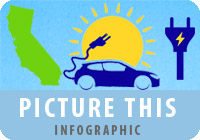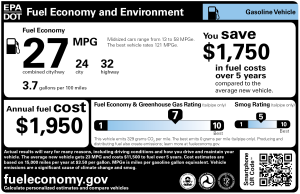See news release about electric car show in Goleta on September 17, 2017.
 Cars and trucks are a major source of smog-forming pollution in Santa Barbara County. They also emit greenhouse gases, which contribute to global climate change. The best thing you can do for our air is to drive less — walk, bike, carpool, combine car trips, or take the bus whenever you can. Try telecommuting.
Cars and trucks are a major source of smog-forming pollution in Santa Barbara County. They also emit greenhouse gases, which contribute to global climate change. The best thing you can do for our air is to drive less — walk, bike, carpool, combine car trips, or take the bus whenever you can. Try telecommuting.
When you drive in your current vehicle, combine car trips, carpool, keep your car tuned up and your tire pressures up, and don’t top off your gas tank — stop fueling when the pump shuts off.
If you’re in the market to buy a vehicle, buying a clean-air car is another step to help keep our air clean.  Whether you are doing web research ahead of time, talking to friends, making some phone calls, or visiting car dealerships, there are several things to consider.
Whether you are doing web research ahead of time, talking to friends, making some phone calls, or visiting car dealerships, there are several things to consider.
Things to Consider
Check the Fuel Economy and Environment label on the car. This label provides a smog rating, and a rating for fuel economy and greenhouse gas emissions.

Look for a newer model. Brand-new models have to meet the strictest standards. If you are looking at a used car, look for one six years old or newer.
Look at the fuel efficiency rating as well as the air pollution rating. The two don’t always go hand in hand, but fuel-efficient cars are often less polluting. The better the fuel economy, the less production of carbon dioxide, a greenhouse gas that contributes to global climate change.
Comparing Vehicles
- Internal Combustion Vehicles — typically powered by the burning of petroleum fuels
- Battery Electric Vehicles — powered by electricity that is stored onboard in rechargeable batteries
- Hybrid Vehicles — powered by both an internal combustion engine and a rechargable battery
- Plug-In Hybrid Vehicles — hybrid vehicles with larger batteries that can be reacharged when the vehicle is not in use
- Fuel Cell Electric Vehicles — rely primarily on hydrogen for fuel to produce electricity
What’s Ahead
We are living in an exciting time for clean vehicle technologies. In the next few years, automakers will be offering more all-electric (also known as battery-electric) and plug-in hybrid electric vehicle models, with increased driving ranges. Even accounting for the emissions associated with the electricity for charging the batteries, EVs are considered much cleaner than their gasoline counterparts. The State of California notes that EV-charging costs typically come in below gasoline costs for gasoline vehicles.
Hydrogen fuel cell electric vehicles (FCEVs) are zero-emission vehicles and run on compressed hydrogen that is processed in a fuel cell to produce electricity. By 2020, automakers expect to make FCEVs widely available to California consumers.
The District is working with partners in the community to improve public EV-charging infrastructure in Santa Barbara County, as well as regionally. See more information on our EV Charging Station Program or contact Jim Fredrickson at (805) 961-8892.
Frequently Asked Questions
Do I have to pay more for a car that’s better for our air?
Not necessarily. Dealers today offer a range of less-polluting, fuel-efficient models, and there are a variety of cash incentives and lease packages for zero-emission vehicles. You may be able to find a very low-emission version of your favorite vehicle model — and driving a more fuel-efficient car will reduce fuel costs.
Should I get a hybrid, a plug-in hybrid, a battery-electric, or a fuel cell vehicle?
After you determine your budget and the type of vehicle you want, compare by air emissions, fuel efficiency, driving range, and other factors important to you. Hybrids are fuel-efficient, but so are many gas-powered cars. Battery-electric vehicles, plug-in hybrids, and fuel cell vehicles are good options for our air and for our planet.
Do SUVs, minivans, and trucks have different emissions standards than cars?
No. As of 2004, the Environmental Protection Agency requires these vehicles to comply with the same national pollution standards as cars. However, there are significant differences between vehicles in these categories, and there are some large electric and hybrid vehicles available. Compare pollution and fuel-efficiency ratings.
Learn More
California Air Resources Board Guide to Cleaner Cars

